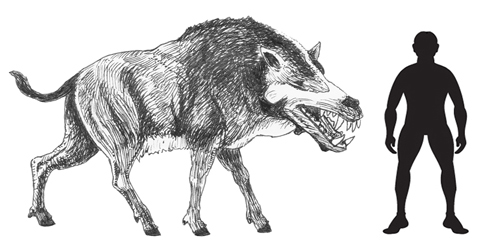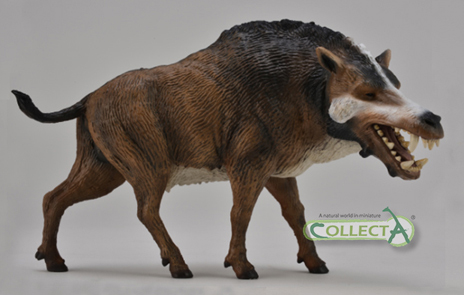Enigmatic Entelodonts – The Mighty Daeodon
If prizes were given for the ugliest animals to have lived on Earth, then the Entelodontidae would probably find themselves somewhere on the podium. These hoofed mammals (artiodactyls) have been nicknamed “terminator pigs”, a reference to the fact that these brutish animals come from the same branch of the hoofed mammals, the ungulates, as pigs, however, recent research suggests that the eight or nine genera that make up the Entelodontidae family are probably more closely related to hippos and whales. However, a Daeodon model (member of the Entelodontidae), has been produced.
The Mighty Daeodon
With evolutionary roots somewhere in the middle Eocene epoch, the largest of the entelodonts could have reached lengths in excess of three metres and weighed as much as three Steinway grand pianos.
Fossilised footprints and bone bed discoveries suggest that these omnivores lived in small family groups and that during the Oligocene and the early part of the Miocene epoch, they became adapted to open, savannah-like habitats. The long legs would have helped them cover large territories as well as helping them to adapt to a pursuit hunting habit. The strong neck muscles helped support a skull that in some species was over a metre long. The thickly enamelled teeth and those large fangs located on both the upper and lower jaws would have given this prehistoric mammal a devastating bite.
One of Nature’s “Unloved Ones” – A Daeodon

One of the “ugly ones”. An illustration of the entelodont Daeodon. Everything Dinosaur discusses the CollectA Daeodon model.
Picture credit: Everything Dinosaur
Everything Dinosaur
At Everything Dinosaur, we describe the larger entelodonts, animals such as Daeodon shoshonensis, from the Early Miocene of North America as “walking waste disposal units”. With their muscular bodies, fearsome features and cloven hooves they may not have won many beauty contests but they were very well adapted and the entelodonts seemed capable of eating almost anything from fallen fruit, tree bark and grubs to scavenging the bodies of dead animals.
They may have been very effective hunters, but their enormously strong jaws and powerful, crushing teeth were capable of breaking bones – giving them access to parts of a carcase such as the nutritious bone marrow, that most other scavengers such as Hyaenodons could not reach.
To view the range of prehistoric mammal models available from Everything Dinosaur: Models of Prehistoric Mammals.
Daeodon Model
Many of the fossil skulls of large entelodonts show evidence of extensive pathology. Smashed eye sockets, crushed cheek bones, puncture wounds running down the long snout, these are quite common. Palaeontologists have puzzled over how these facial injuries could have occurred and most believe, that these injuries were inflicted by other entelodonts, perhaps in fights over social dominance, or disputes over mates or food. In one, well documented example, it seems that one entelodont managed to clamp its jaws across the skull of another. The bite marks preserved in the maxilla and dentary are in some instances over five centimetres deep. Despite this extensive damage, the attacked entelodont survived.
The CollectA Daeodon Replica
Picture credit: Everything Dinosaur
Models of entelodonts are rare, but fortunately, CollectA introduced a 1:20 scale replica of a Daeodon (entelodont) this year (2015). The hand-painted model shows fantastic detail and it measures over sixteen centimetres long. It is a wonderful figure and although these mammals are often regarded as one of nature’s unloved ones, the Daeodon figure, with its white face markings is certainly striking.
To view the complete range of Deluxe CollectA models: CollectA Deluxe Prehistoric World.






